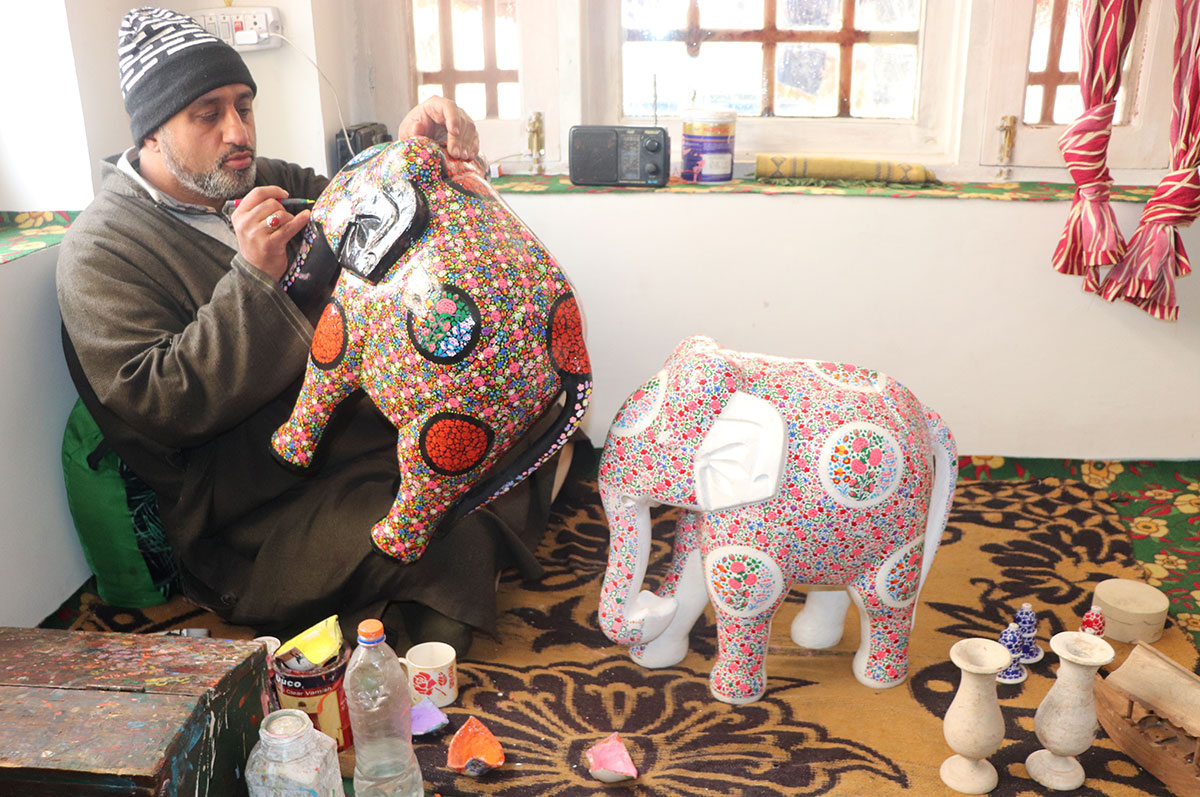Dwindling economic utility of the art is forcing artisans in Kashmir villages to give up on it, reports Samreena Nazir

Fayaz Ahmad Jan
On a snowy afternoon of January, facing towards the only window of the room, surrounded with broken cups holding variety of colors, Fayaz Ahmad Jan, 45 ,is keenly moving brushes over an elephant made of paper pulp. Spending most of his time in a room where every item around is decorated with alluring colors, his puffy eyes with dark circles reflect his dedication towards the art of Papermachie. He has been practicing the art since 30 years.
“This art was passed down from our ancestors to us, who had learned it from, a famous papermachie artist, Mohammad Yousuf Naqash, of Alamgir bazaar Srinagar,” says Jan of Shahoo village in Kulgam.
Before nineties, every individual in Jan’s locality was associated with paper-machie and this craft was the only source of income for the villagers. Jan as a kid would be attracted towards colors, he used to observe his uncle’s fingers while decorating the items with different colors and designs.
Soon Jan earned the mastery over the art, left his school and joined the village’s common workshop. “I spent my childhood surrounded by colors, artists and papermachie items. Men from the village would do papermachie while women used to support them by making a paste of paper for making a crude shape of a thing which was later decorated by the artists,”says Jan.
A little distance from Jan’s house, a three storey mud building stands witness to the art of papermachie in the village. The building used to be a common center for the papermachie workers of the village, where they would jointly work throughout the year.
The center was more like an office for the crafts men, where they used to spend six hours a day and experiment new ideas and designs.“Years before, there used to be a crowd of papermachie workers in the building. Every individual associated with papermachie would attend the center,” says Jan. “The center would keep the village artists linked with one another and would produce items like jewellary boxes, soap cases, flower vase and other items ordered by people”.
After 2000, the art lost its centrality in the village and so did the workshop. Apart from paper-machie, the artists would make paper pulp for items in the village. The rubbing sound of piston and mortar, for crushing paper pulp by women would buzz through the village.
“When the village work shop produced items, we were unable to supply it. ,There is no market for such items in the villages so we were dependent on middlemen who had contacts with businessmen of Srinagar,” says Jan. “As we used to make paper pulp on our own, the middlemen earned less from our stock so they would refuse to take our items. As a result, the young workers shifted to other professions while others turned their homes into workshops where they work in groups”..
Says Mohammad Yusuf Meer, one of the best artists in the village: “Till last year I used to have a dozen of workers at my house but gradually all of them left, probably because of less wages they earned.
To compete with his friends from well-off families during school time, Mir, then a primary student would work with the overtime workers at the workshop after returning from school. It was the time, when the government employees of the village used to leave their jobs and learn papermachie.
Although, papermachie demands a lot of patience and focus but people used to enjoy it till the time it satisfied their needs. “We used to earn a healthy amount, in fact, this craft was preferred over government jobs My brother, who is now posted in Jammu as Sub-Inspector of police left his job for seven months to work in the common center of village where he earned more than his government job,” says Meer.
For few years, Meer’s earnings were satisfactory like other workers in the village. Almost every worker received loan from Khadi and Village Industries Department to expand their business. “Everything was going smooth till the villagers became dependent on orders from middlemen who cornered the major portion of profit,” says Meer.

Mohammad Yousuf Mir
The artists receive the paper pulp from the middle men, work on it on lesser wages, and then supply it back to them,The middlemen then send it to the one who has export license.
“The middlemen receive the items from us at low rates and then sell it on expensive rates in the market,” says Meer, who is an electrician and a part-time papiermachie artist. “I remember, once a middleman took a 33 inch flower vase from me for Rs four thousand which he later sold for Rs 42 thousand”.
Pointing towards a fish shaped soap case, Meer says: “This took me one and half day and I would earn a meager seventy rupees for it.
“This art is actually city centered as it flourishes in Srinagar because it is a tourist destination,” says Meer. “We don’t teach this art to anyone anymore in the village even if they insist because we don’t want to ruin their future as ours, I practice it out of compulsion now because I can’t learn new things now,”
from Kashmir Life https://ift.tt/2SZqV1y
via IFTTThttps://kashmirlife.net
No comments:
Post a Comment